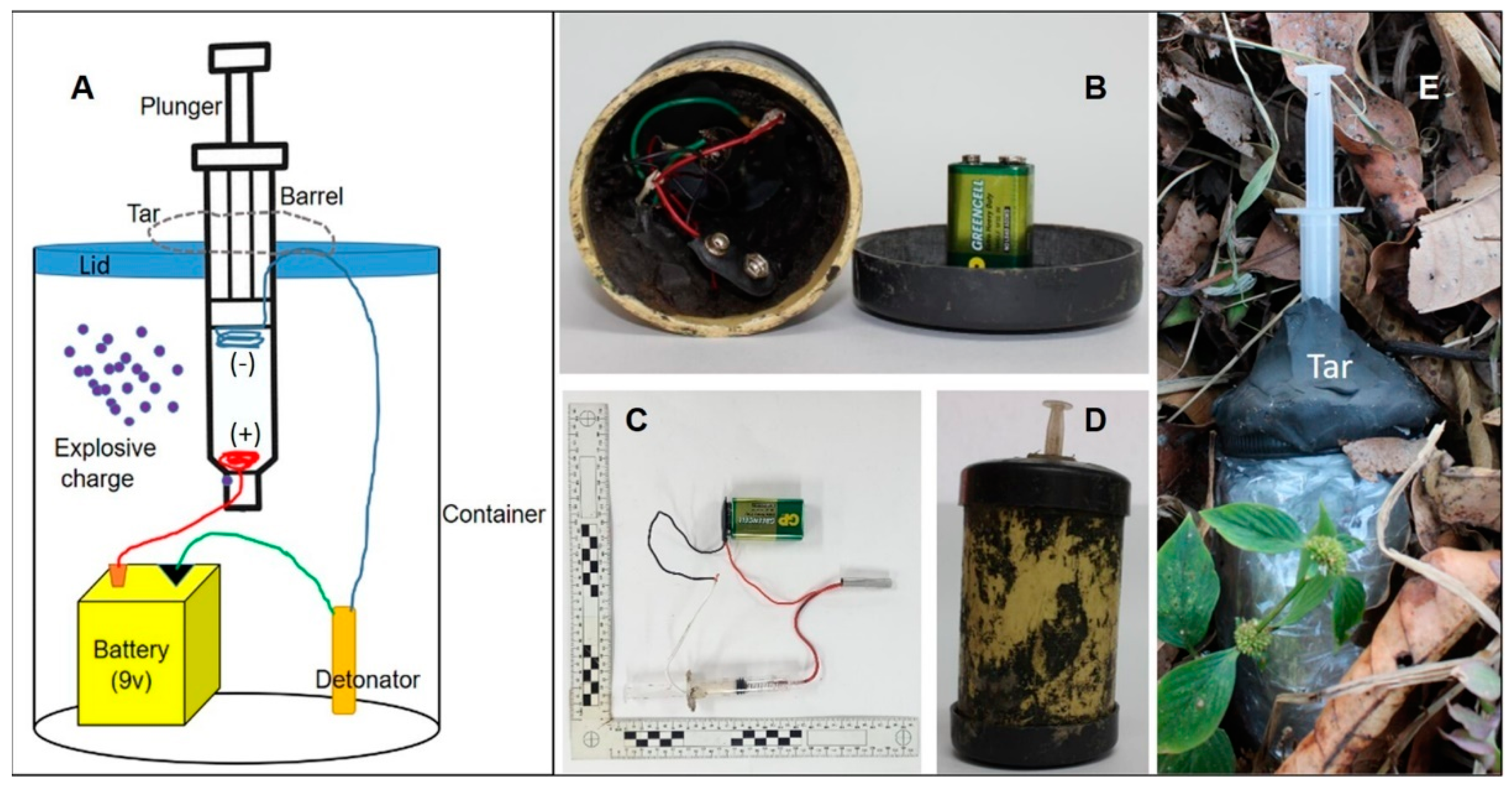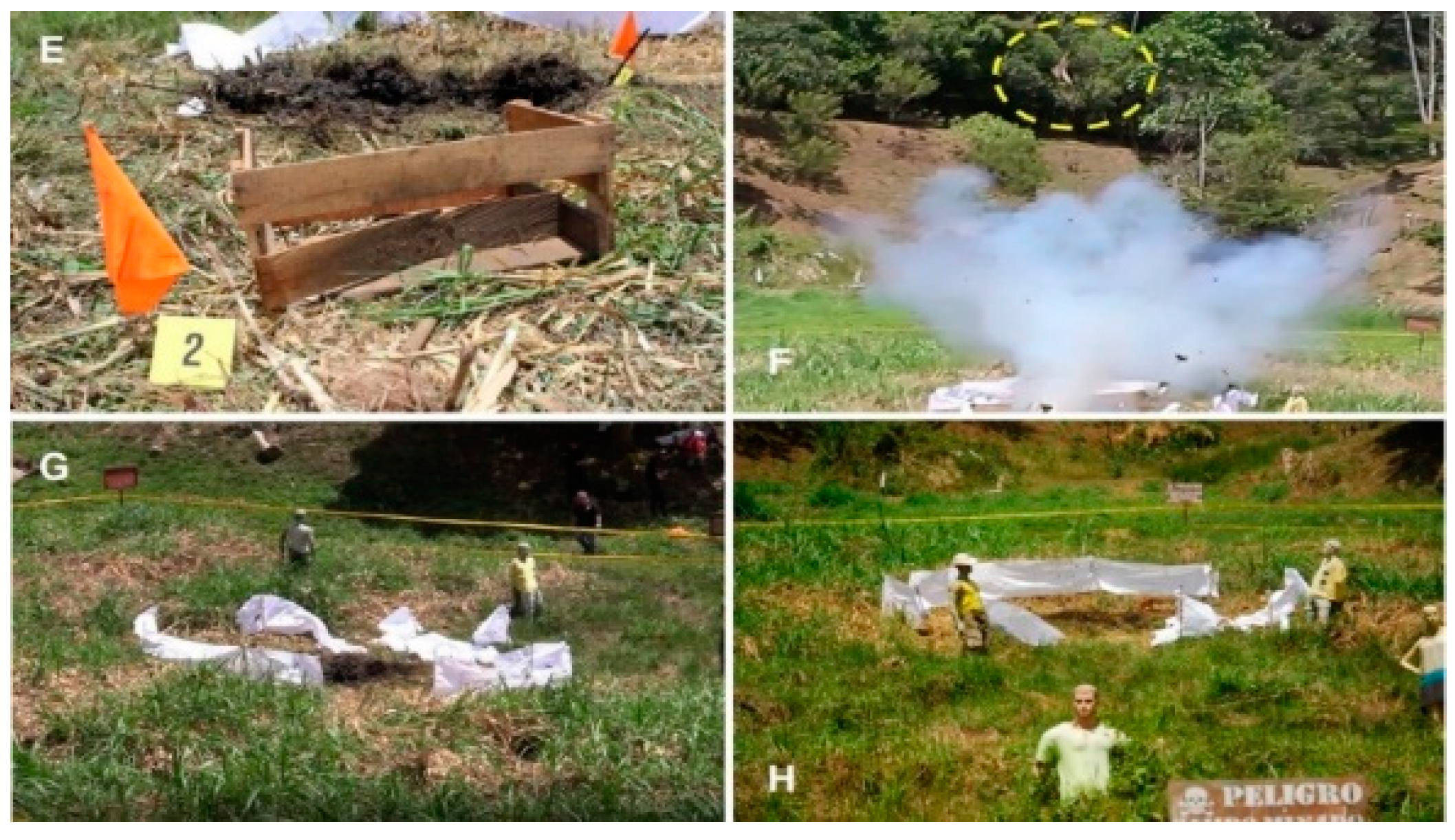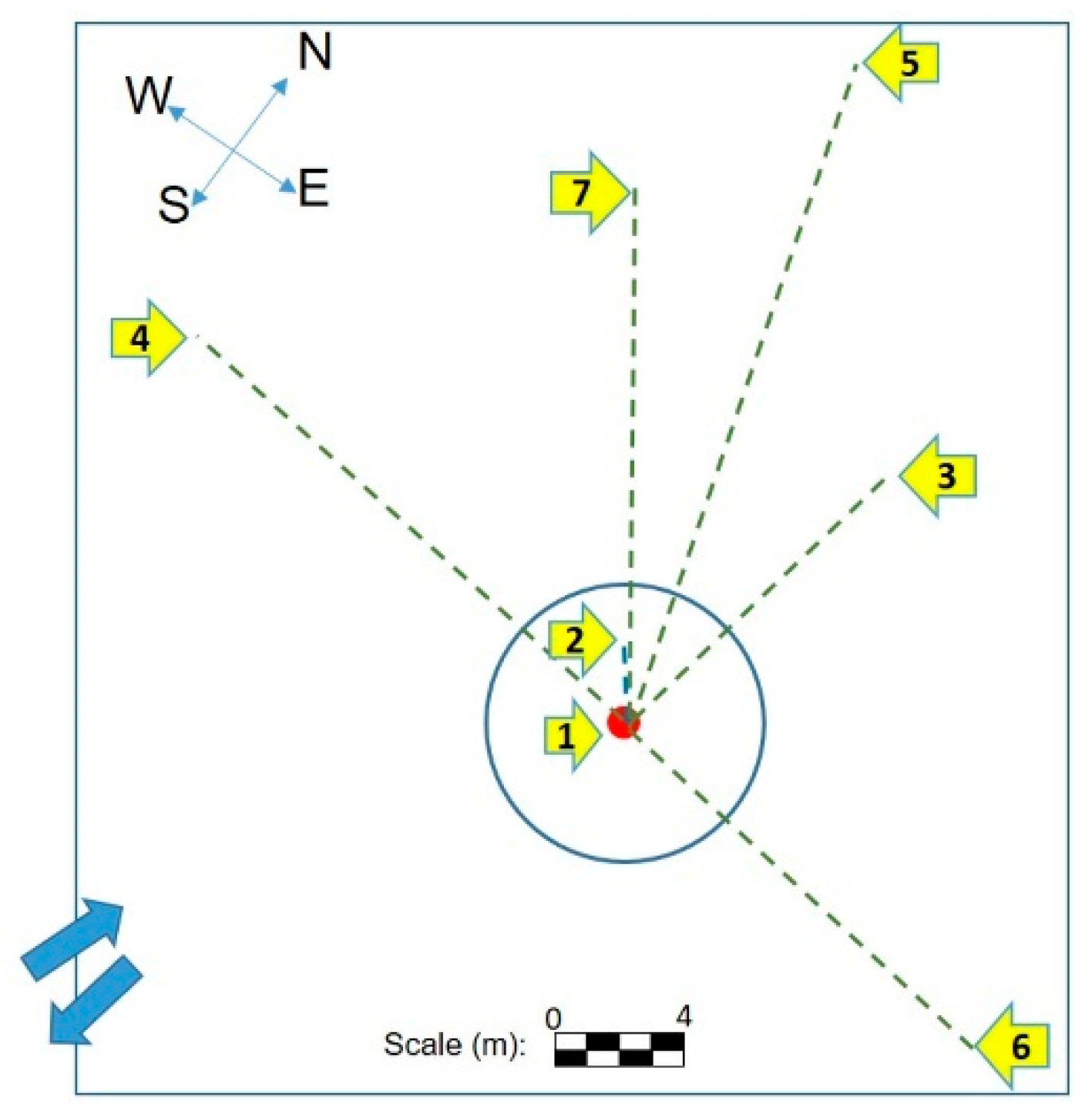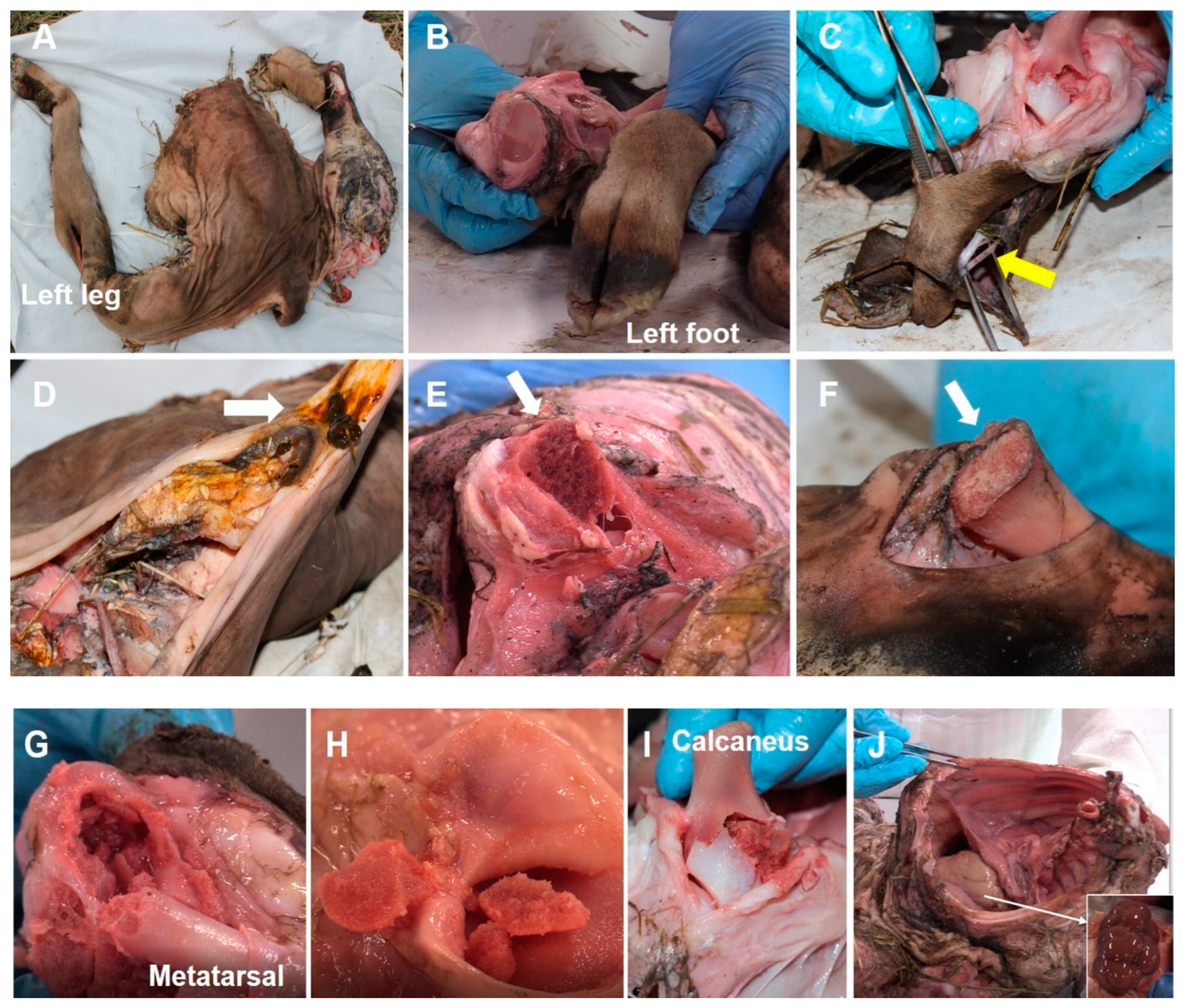Preliminary Considerations for Crime Scene Analysis in Cases of Animals Affected by Homemade Ammonium Nitrate and Aluminum Powder Anti-Personnel Landmines in Colombia: Characteristics and Effects
Abstract
Simple Summary
Abstract
1. Introduction
2. Materials and Methods
2.1. Homemade AP Landmine Design
2.2. Biological Sample
2.3. Considered Variables
2.4. Radius of the Action of the Explosion on the Dispersion, Distance and Distribution of Projected Fragments
2.5. Evidence Research
3. Results
3.1. Detonation Characteristics and Transitory Evidence
3.2. The Explosion’s Effect on Elements Present in the Blast Radius of Action
3.3. Research Patterns
3.4. Physical Evidence Found during the Search Process
3.5. The Effects of the Explosion on the Part of the Carcass
4. Discussion
4.1. General Aspects of the Effects of the Explosion
4.2. Effects on Part of Carcass
4.3. Work at the Crime Scene or Investigation Site
5. Conclusions
Author Contributions
Funding
Institutional Review Board Statement
Informed Consent Statement
Data Availability Statement
Acknowledgments
Conflicts of Interest
References
- Negret, P.J.; Allan, J.; Braczkowski, A.; Maron, M.; Watson, J.E.M. Need for conservation planning in postconflict Colombia. Conserv. Biol. 2017, 31, 499–500. [Google Scholar] [CrossRef]
- Castro-Nunez, A.; Mertz, O.; Buritica, A.; Sosa, C.C.; Lee, S.T. Land related grievances shape tropical forest-cover in areas affected by armed-conflict. Appl. Geogr. 2017, 85, 39–50. [Google Scholar] [CrossRef]
- International Campaign to Ban Landmines—Cluster Munition Coalition (ICBL-CMC). Cluster Munition Monitor 2021. Available online: http://www.the-monitor.org/en-gb/reports/2021/cluster-munition-monitor-2021.aspx (accessed on 11 January 2022).
- Jaramillo, C. Análisis Forense y Criminalístico de las Minas-Antipersonal Artesanales; Detectables y no Detectables Enfocado en el Conflicto Armado Colombiano. Master’s Thesis, University of Medellín, Medellín, Colombia, 2019. [Google Scholar]
- Prada, P.A.; Chávez Rodríguez, M. Demining dogs in Colombia—A review of operational challenges, chemical perspectives, and practical implications. Sci. Justice 2016, 56, 269–277. [Google Scholar] [CrossRef] [PubMed]
- Mohana, M.A.; Abbas, A.M.; Gomaa, M.L.; Ebrahim, S.M. Discrimination between landmine and mine-like targets using wavelets and spectral analysis. NRIAG J. Astron. Geophys. 2013, 2, 54–66. [Google Scholar] [CrossRef][Green Version]
- Roberts, A.; Stewart, K. Animal casualties of the underground war. J. Mine Action 1999, 3, 32–33. [Google Scholar]
- Trimble, K.; Clasper, J. Anti-personnel mine injury; Mechanism and medical management. J. R. Army Med. Corps 2001, 147, 73–79. [Google Scholar] [CrossRef]
- Thurman, J. Practical Bomb Scene Investigation (Practical Aspects of Criminal and Forensic Investigations), 3rd ed.; CRC Press: Boca Raton, FL, USA, 2017. [Google Scholar]
- Vega, J.A.; Sahli, H.; Sellier, A.G. Antipersonnel landmines in the colombian internal conflict: Implications for technology development. DYNA 2020, 87, 144–154. [Google Scholar] [CrossRef][Green Version]
- Jaramillo- Gutierrez, C.A.; Londoño-Pineda, A.A.; Vélez Rojas, O.A. Non-conventional anti-personnel landmines and sustainable livelihoods in Colombian rural areas. Dyn. Asymmetr. Confl. 2021, 14, 247–258. [Google Scholar] [CrossRef]
- Malavera, A.; Silva, F.A.; Fregni, F.; Carrillo, S.; Garcia, R.G. Repetitive transcranial magnetic stimulation for phantom limb pain in land mine victims: A double-blinded, randomized, sham-controlled trial. J. Pain 2016, 17, 911–918. [Google Scholar] [CrossRef]
- Lawrence, M.J.; Stemberger, H.L.J.; Zolderdo, A.J.; Struthers, D.P.; Cooke, S.J. The effects of modern war and military activities on biodiversity and the environment. Environ. Rev. 2015, 23, 443–460. [Google Scholar] [CrossRef]
- Al-Hajj, S.; Dhaini, H.R.; Mondello, S.; Kaafarani, H.; Kobeissy, F.; DePalma, R.G. Beirut ammonium nitrate blast: Analysis, review, and recommendations. Front. Public Health 2021, 9, 657996. [Google Scholar] [CrossRef] [PubMed]
- González-Huici, M.A.; Giovanneschi, F. A combined strategy for landmine detection and identification using synthetic gpr responses. J. Appl. Geophys. 2013, 99, 154–165. [Google Scholar] [CrossRef]
- Harjai, M.M.; Agarwal, D.; Dave, P.; Jog, S.; Arora, P. Mine blast injuries—Our experience. Med. J. Armed Forces India 2005, 61, 143–147. [Google Scholar] [CrossRef]
- Ivashov, S.; Razevig, V.; Sheyko, A.; Vasilyev, I. A review of the remote sensing laboratory’s techniques for humanitarian demining. In Proceedings of the International Conference Requirements and Technologies for the Detection, Removal and Neutralization of Landmines and UXO, VUB, Vrije Universiteit Brussel, Brussels, Belgium, 15–18 September 2003; pp. 3–8. [Google Scholar]
- MacDonald, J.; Lockwood, J.R.; McFee, J.; Altshuler, T.; Broach, T.; Carin, L.; Harmon, R.; Rappaport, C.; Scott, W.; Weaver, R. Alternatives for Landmine Detection; RAND Corporation: Santa Monica, CA, USA, 2003. [Google Scholar]
- Bergeron, D.; Anderson, I.; Coley, G.; Fall, R. Assessment of Lower Leg Injury from Land Mine Blast—Phase 1: Test Results Using a Frangible Surrogate Leg with Assorted Protective Footwear and Comparison with Cadaver Test Data; Defence Research and Development Canada: Ottawa, Canada, 2006. [Google Scholar]
- Ramasamy, A.; Hill, A.; Masouros, S.D.; Gibb, I.E.; Bull, A.M.J.; Clasper, J.C. Blast-related fracture patterns: A forensic biomechanical approach. J. R. Soc. Interface 2011, 8, 689–698. [Google Scholar] [CrossRef] [PubMed]
- National Fire Protection Association (NFPA). Guide for Fire and Explosion Investigations; NFPA: Quincy, MA, USA, 2021. [Google Scholar]
- Gardner, R.; Krouskup, D. Practical Crime Scene Processing and Investigation: Practical Aspects of Criminal and Forensic Investigations, 3rd ed.; CRC Press: Boca Raton, FL, USA, 2019. [Google Scholar]
- Bone, L.; Mamczak, C. Front Line Extremity and Orthopaedic Surgery: A Practical Guide; Springer: Berlin/Heidelberg, Germany, 2014. [Google Scholar]
- Cullis, I.G. Blast waves and how they interact with structures. J. R. Army Med. Corps 2001, 147, 16–26. [Google Scholar] [CrossRef] [PubMed]
- Grujicic, M.; Pandurangan, B.; Qiao, R.; Cheeseman, B.A.; Roy, W.N.; Skaggs, R.R.; Gupta, R. Parameterization of the porous-material model for sand with different levels of water saturation. Soil Dyn. Earthq. Eng. 2008, 28, 20–35. [Google Scholar] [CrossRef]
- Ramasamy, A.; Hill, A.; Hepper, A.E.; Bull, A.; Clasper, J. Blast mines: Physics, injury mechanisms and vehicle protection. J. R. Army Med. Corps 2009, 155, 258–264. [Google Scholar] [CrossRef]
- Edlich, R.F.; Moghtaler, J.C. Thermal burns. In Emergency Medicine: Concepts and Clinical Practice, 4th ed.; Rosen, P., Barkin, R., Eds.; Mosby: St. Louis, MO, USA, 1998. [Google Scholar]
- Togunov, R.; Derocher, A.; Lunn, N. Windscapes and olfactory foraging in a large carnivore. Sci. Rep. 2017, 7, 46332. [Google Scholar] [CrossRef]
- Rankin, I.A.; Nguyen, T.-T.; McMenemy, L.; Clasper, J.C.; Masouros, S.D. The injury mechanism of traumatic amputation. Front. Bioeng. Biotechnol. 2021, 9, 665248. [Google Scholar] [CrossRef]
- Coupland, R.M.; Korver, A. Injuries from antipersonnel mines: The experience of the international committee of the red cross. BMJ 1991, 303, 1509–1512. [Google Scholar] [CrossRef]
- Hull, J.B.; Cooper, G.J. Pattern and mechanism of traumatic amputation by explosive blast. J. Trauma Acute Care Surg. 1996, 40, 198S–205S. [Google Scholar] [CrossRef] [PubMed]
- Dussault, M.; Smith, M.; Osselton, D. Blast injury and the human skeleton: An important emerging aspect of conflict-related trauma. J. Forensic Sci. 2014, 59, 606–612. [Google Scholar] [CrossRef] [PubMed]
- Wedel, V.; Galloway, A. Broken Bones: Anthropological Analysis of Blunt Force Trauma, 2nd ed.; Charles C Thomas: Springfield, IL, USA, 2014. [Google Scholar]
- Smith, S.; Devine, M.; Taddeo, J.; McAlister, V.C. Injury profile suffered by targets of antipersonnel improvised explosive devices: Prospective cohort study. BMJ Open 2017, 7, e014697. [Google Scholar] [CrossRef]
- Covey, D.C.; Born, C.T. Blast injuries: Mechanics and wounding patterns. J. Surg. Orthop. Adv. 2010, 19, 8–12. [Google Scholar] [PubMed]
- Wakeley, C.G. Effect of underwater explosions on the human body. Lancet 1945, 245, 715–718. [Google Scholar] [CrossRef]
- Godfrey, B.W.; Martin, A.; Chestovich, P.J.; Lee, G.H.; Ingalls, N.K.; Saldanha, V. Patients with multiple traumatic amputations: An analysis of operation enduring freedom joint theatre trauma registry data. Injury 2017, 48, 75–79. [Google Scholar] [CrossRef] [PubMed]
- Korver, A.J.H. Injuries of the lower limbs caused by antipersonnel mines: The experience of the international committee of the red cross. Injury 1996, 27, 477–479. [Google Scholar] [CrossRef]
- Kress, T.A.; Porta, D.J.; Snider, J.N.; Fuller, P.M.; Psihogios, J.P.; Heck, W.L.; Frick, S.J.; Wasserman, J.F. Fracture patterns of human cadaver long bones. In Proceedings of the International Research Council on the Biomechanics of Impact, Brunnen, Switzerland, 13–15 September 1995; Volume 23, pp. 155–169. [Google Scholar]
- Rankin, I.A.; Nguyen, T.-T.; Carpanen, D.; Clasper, J.C.; Masouros, S.D. A new understanding of the mechanism of injury to the pelvis and lower limbs in blast. Front. Bioeng. Biotechnol. 2020, 8, 960. [Google Scholar] [CrossRef]
- Christensen, A.M.; Smith, V.A.; Ramos, V.; Shegogue, C.; Whitworth, M. Primary and secondary skeletal blast trauma. J. Forensic Sci. 2012, 57, 6–11. [Google Scholar] [CrossRef]
- Huelke, D.F.; Harger, J.H.; Buege, L.J.; Dingman, H.G.; Harger, D.R. An experimental study in bio-ballistics: Femoral fractures produced by projectiles. J. Biomech. 1968, 1, 97–105. [Google Scholar] [CrossRef]
- König, H.; Liebich, H.-G. Veterinary Anatomy of Domestic Animals: Textbook and Colour Atlas, 7th ed.; Thieme Publishing Group: New York, NY, USA, 2020. [Google Scholar]
- Carter, D.R.; Van der Meulen, M.C.H.; Beaupré, G.S. Mechanical factors in bone growth and development. Bone 1996, 18, S5–S10. [Google Scholar] [CrossRef]
- Viguet-Carrin, S.; Garnero, P.; Delmas, P. The role of collagen in bone strength. Osteoporos. Int. 2006, 17, 319–336. [Google Scholar] [CrossRef]
- Shefelbine, S.J.; Carter, D.R. Mechanobiological predictions of growth front morphology in developmental hip dysplasia. J. Orthop. Res. 2004, 22, 346–352. [Google Scholar] [CrossRef]
- U.S. Department of Justice Office of Justice Programs. A Guide for Explosion and Bombing Scene Investigation; National Institute of Justice: Washington, DC, USA, 2000; p. 64.
- Ağırdil, Y. The growth plate: A physiologic overview. EFORT Open Rev. 2020, 5, 498–507. [Google Scholar] [CrossRef]
- Gaynor, K.M.; Fiorella, K.J.; Gregory, G.H.; Kurz, D.J.; Seto, K.L.; Withey, L.S.; Brashares, J.S. War and wildlife: Linking armed conflict to conservation. Front. Ecol. Environ. 2016, 14, 533–542. [Google Scholar] [CrossRef]
- Radle, A.L. The Effect of Noise on Wildlife: A Literature Review. 2007. Available online: https://winapps.umt.edu/winapps/media2/wilderness/toolboxes/documents/sound/radle_effect_noise_wildlife.pdf. (accessed on 15 February 2022).
- Merrifield, R. Fire and explosion hazards to flora and fauna from explosives. J. Hazard. Mater. 2000, 74, 149–161. [Google Scholar] [CrossRef]
- Eniang, E.; Haile, A.; Yihdego, T. Impacts of landmines on the environment and biodiversity. Environ. Policy Law 2007, 37, 501–504. [Google Scholar]
- Fraser, M. Landmines: An ongoing environmental health problem for the children of Afghanistan. J. Rural. Remote Environ. Health 2003, 2, 76–89. [Google Scholar]
- Larkin, R.P.; Pater, L.L.; Tazik, D.J. Effects of Military Noise on Wildlife. A Literature Review; Center for Wildlife Ecology: Champaign, IL, USA, 1996. [Google Scholar]
- Robbins, D.L.; Anderson, E.K.; Anderson, M.U.; Jackson, S.I.; Short, M. Cylinder test characterization of an ammonium nitrate and aluminum powder explosive. In Proceedings of the 15th International Detonation Symposium, Office of Naval Research, Los Alamos and Albuquerque, NM, USA, 13–18 July 2014; pp. 797–803. [Google Scholar]










| Evidences | Distance from Crater (m) |
|---|---|
| Wooden box | 2.15 |
| Fragment of spleen | 9 |
| Largest portion of the part of the carcass | 14.4 |
| Fragment of the AP landmine | 19.4 |
| Soft tissue | 15.6 |
| Particle of soil expelled from center of the crater | 13 |
Publisher’s Note: MDPI stays neutral with regard to jurisdictional claims in published maps and institutional affiliations. |
© 2022 by the authors. Licensee MDPI, Basel, Switzerland. This article is an open access article distributed under the terms and conditions of the Creative Commons Attribution (CC BY) license (https://creativecommons.org/licenses/by/4.0/).
Share and Cite
Gutiérrez, C.J.; Roldán, G.F.; Severin, K.; Orozco, U.M.; García, P.M.; González, V.T. Preliminary Considerations for Crime Scene Analysis in Cases of Animals Affected by Homemade Ammonium Nitrate and Aluminum Powder Anti-Personnel Landmines in Colombia: Characteristics and Effects. Animals 2022, 12, 1938. https://doi.org/10.3390/ani12151938
Gutiérrez CJ, Roldán GF, Severin K, Orozco UM, García PM, González VT. Preliminary Considerations for Crime Scene Analysis in Cases of Animals Affected by Homemade Ammonium Nitrate and Aluminum Powder Anti-Personnel Landmines in Colombia: Characteristics and Effects. Animals. 2022; 12(15):1938. https://doi.org/10.3390/ani12151938
Chicago/Turabian StyleGutiérrez, Carlos Jaramillo, Gustavo Farías Roldán, Krešimir Severin, Ubicelio Martin Orozco, Pilar Marín García, and Víctor Toledo González. 2022. "Preliminary Considerations for Crime Scene Analysis in Cases of Animals Affected by Homemade Ammonium Nitrate and Aluminum Powder Anti-Personnel Landmines in Colombia: Characteristics and Effects" Animals 12, no. 15: 1938. https://doi.org/10.3390/ani12151938
APA StyleGutiérrez, C. J., Roldán, G. F., Severin, K., Orozco, U. M., García, P. M., & González, V. T. (2022). Preliminary Considerations for Crime Scene Analysis in Cases of Animals Affected by Homemade Ammonium Nitrate and Aluminum Powder Anti-Personnel Landmines in Colombia: Characteristics and Effects. Animals, 12(15), 1938. https://doi.org/10.3390/ani12151938





